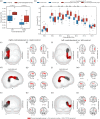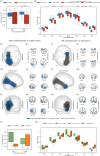Structural White Matter Correlates of the Crowding Effect: Insights From a Tractography Study of the Arcuate Fasciculus Post-Hemispherotomy
- PMID: 40536189
- PMCID: PMC12177811
- DOI: 10.1002/hbm.70258
Structural White Matter Correlates of the Crowding Effect: Insights From a Tractography Study of the Arcuate Fasciculus Post-Hemispherotomy
Abstract
The neuropsychological crowding effect denotes the reallocation of cognitive functions within the contralesional hemisphere following unilateral brain damage, prioritizing language at the expense of nonverbal abilities. This study investigates structural white matter correlates of crowding in the arcuate fasciculus (AF), a key language tract, using hemispherotomy as a unique setting to explore structural reorganization supporting language preservation. We explore two main hypotheses. First, the contralesional right AF undergoes white matter reorganization correlated with preserved language function at the expense of nonverbal abilities following left-hemispheric damage. Second, this reorganization varies with epilepsy etiology, influencing different stages of developmental language lateralization. This retrospective study included individuals post-hemispherotomy and healthy controls. Inclusion criteria were; (1) being a native German speaker, (2) having no MRI contraindication, (3) the ability to undergo approximately 2 h of MRI scans, and (4) the ability to participate in neuropsychological assessments over two consecutive days. Neuroimaging included T1-, T2-, and diffusion-weighted imaging, alongside postoperative neuropsychological assessments, where it was taken as evidence for crowding if verbal IQ exceeded performance IQ by at least 10 points. The AF was reconstructed using advanced tractography, and CoBundleMAP was used to compare morphologically corresponding AF subsections. Statistical significance was set at , with correction for multiple comparisons applied across contiguous tract sections using Threshold-Free Cluster Enhancement. The final cohort comprised 22 individuals post-hemispherotomy (median age: years, range: ; 55% female; 55% with left-sided surgeries) and 20 healthy controls (median age: years, range: ; 55% female). Crowding was associated with significantly higher fractional anisotropy (FA) in the AF ( , Cohen's ), but only observed in individuals with left-sided hemispherotomy, localized to a subsection between Geschwind's territory and Wernicke's area ( ). This region also displayed significantly higher normalized FA in AF of individuals with congenital etiology and crowding compared to acquired etiology and no crowding ( ). This study identifies previously unreported neural correlates of crowding in right contralesional AF of individuals post-hemispherotomy and highlights specific AF subsections involved in preserving language functions at the cost of nonverbal abilities. The findings suggest a link between crowding and epilepsy etiology, particularly in the region spanning Geschwind's territory and Wernicke's area.
© 2025 The Author(s). Human Brain Mapping published by Wiley Periodicals LLC.
Conflict of interest statement
J.A.W. reports personal fees from Eisai GmbH, UCB Pharma GmbH, and Jazz Pharmaceuticals Germany GmbH, outside the submitted work. R.S. has received personal fees as a speaker or for serving on advisory boards from Angelini, Bial, Desitin, Eisai, Jazz Pharmaceuticals Germany GmbH, Janssen‐Cilag GmbH, LivaNova, LivAssured B.V., Novartis, Precisis GmbH, Rapport Therapeutics, Tabuk Pharmaceuticals, UCB Pharma, UNEEG, and Zogenix. He is an editorial board member of Epilepsy and Behavior and associate editor of Epilepsia Open. These activities were not related to the content of this manuscript. A.R. serves on the scientific advisory boards for GE Healthcare, Bracco, Bayer, Guerbet, and AbbVie; has received speaker honoraria from Bayer, Guerbet, Siemens, and Medscape; and is a consultant for, and has received institutional study support from, Guerbet and Bayer. These activities were not related to the content of this manuscript. The remaining authors declare no competing interests.
Figures






Similar articles
-
Assessing the Early Lateralization of White Matter in the Infant Language Network.Hum Brain Mapp. 2025 Aug 1;46(11):e70286. doi: 10.1002/hbm.70286. Hum Brain Mapp. 2025. PMID: 40698875 Free PMC article.
-
Structural signatures of language reorganization after left hemispherotomy in patients with Rasmussen's encephalitis.Brain Struct Funct. 2025 May 9;230(5):63. doi: 10.1007/s00429-025-02923-7. Brain Struct Funct. 2025. PMID: 40343519
-
Associations of Central Arterial Stiffness With Brain White Matter Integrity and Gray Matter Volume in MRI Across the Adult Lifespan.J Magn Reson Imaging. 2025 Jul;62(1):215-229. doi: 10.1002/jmri.29713. Epub 2025 Jan 10. J Magn Reson Imaging. 2025. PMID: 39792583 Free PMC article.
-
Correlations between Dual-Pathway White Matter Alterations and Language Impairment in Patients with Aphasia: A Systematic Review and Meta-analysis.Neuropsychol Rev. 2021 Sep;31(3):402-418. doi: 10.1007/s11065-021-09482-8. Epub 2021 Mar 3. Neuropsychol Rev. 2021. PMID: 33656701
-
White matter abnormalities at a regional and voxel level in focal and generalized epilepsy: A systematic review and meta-analysis.Neuroimage Clin. 2016 Nov 2;12:902-909. doi: 10.1016/j.nicl.2016.10.025. eCollection 2016. Neuroimage Clin. 2016. PMID: 27882296 Free PMC article.
References
-
- Althausen, A. , Gleissner U., Hoppe C., et al. 2013. “Long‐Term Outcome of Hemispheric Surgery at Different Ages in 61 Epilepsy Patients.” Journal of Neurology, Neurosurgery, and Psychiatry 84, no. 5: 529–536. https://jnnp.bmj.com/content/84/5/529, 10.1136/jnnp-2012-303811. - DOI - PubMed
-
- Bajer, C. , Hofer W., Pieper T., Kudernatsch M., Holthausen H., and Staudt M.. 2020. “Correlates of Intellectual Development Before and After Hemispherotomy: An Analysis of 75 Children and Adolescents.” Epileptic Disorders 22, no. 5: 571–581. https://pubmed.ncbi.nlm.nih.gov/32985986, 10.1684/epd.2020.1193 Lavoisier Paris. - DOI - PubMed
MeSH terms
Grants and funding
LinkOut - more resources
Full Text Sources

